The AMD Radeon RX 590 Review, feat. XFX & PowerColor: Polaris Returns (Again)
by Nate Oh on November 15, 2018 9:00 AM ESTPower, Temperature, and Noise
As always, we'll take a look at power, temperature, and noise of the Radeon RX 590. As a custom-only specification, this means that we will be looking at solely AIB vendor designs. With the RX 590, we already know what to expect with existing RX 580 boards and coolers.
As this is a new GPU, we will quickly review stock voltages and clockspeeds as well.
| AMD RX Series Video Card Voltages | ||||
| Boost | Idle | |||
| Radeon RX 590 | 1.1563V | 0.8000V | ||
| Radeon RX 580 | 1.1625v | 0.7625v | ||
| Radeon RX 480 | 1.0625v | |||
Power Consumption
For all the gaming performance gains that the RX 590 has made, it came with the higher clockspeeds, and to bring those higher clockspeeds came more power. Already, TBPs have notably increased from the RX 480's 150W to the RX 580's 185W, and now to the RX 590's 225W. Which is already past RX Vega 56's 210W reference board power spec.
Idle power consumption doesn't show anything out of the ordinary.
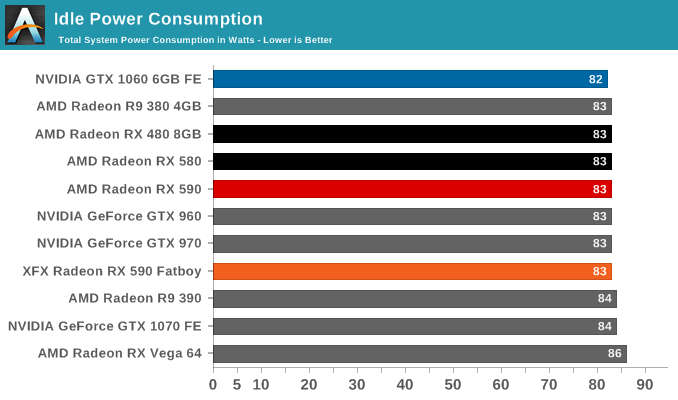
The RX 590's load power consumption is a slightly different story. For the RX 580 launch, we mused that this is where AMD paid the piper. For the RX Vega launch, I commented that the piper had then taken AMD to the cleaners. For the RX 590 today, I thought there wasn't any more the piper wanted to take, but there was.
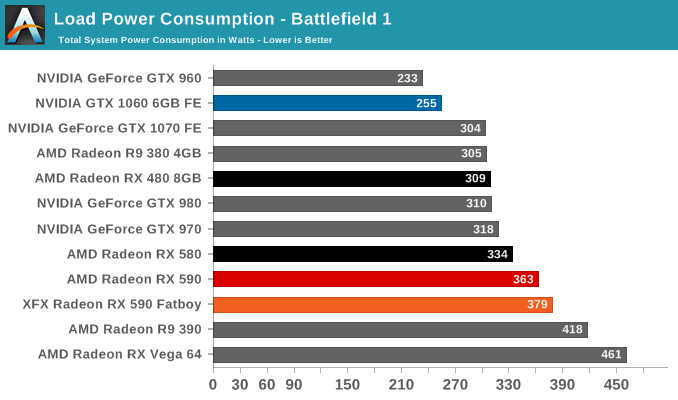
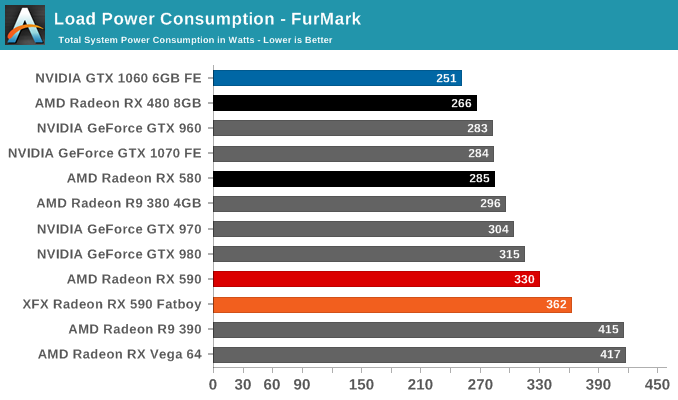
From the wall, the RX 590 now pulls 30 to 45W more than the RX 580 in Battlefield 1. The difference in FurMark is even starker, with the RX 590 now drawing 45 to 80W more. Naturally, the power delta gets higher when comparing to the RX 480, let alone the GTX 1060 6GB FE. In Battlefield 1, that's 110W or more system consumption than the GTX 1060 6GB FE for what is panning out to be around 10% faster performance. It's clear that the RX 590 is not in the same league - or anywhere close - to the GTX 1060 in terms of power efficiency.
Temperature
With all that power, heat and temperature can easily become an issue. But as both a non-reference launch and a product refresh, the featured open air axial fan designs are tried-and-true, and already configured to dissapate similar thermals.
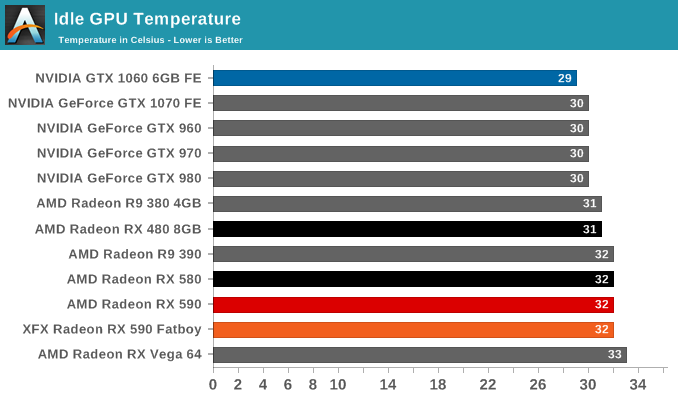

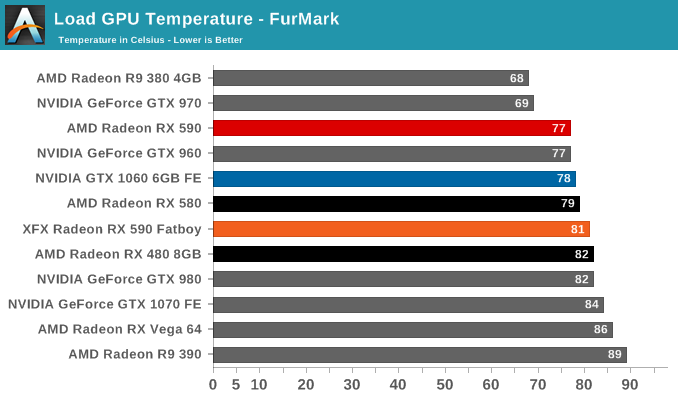
Noise
Likewise with noise, the RX 590 can benefit from zero dB functionality, where fans turn off under certain temperatures.
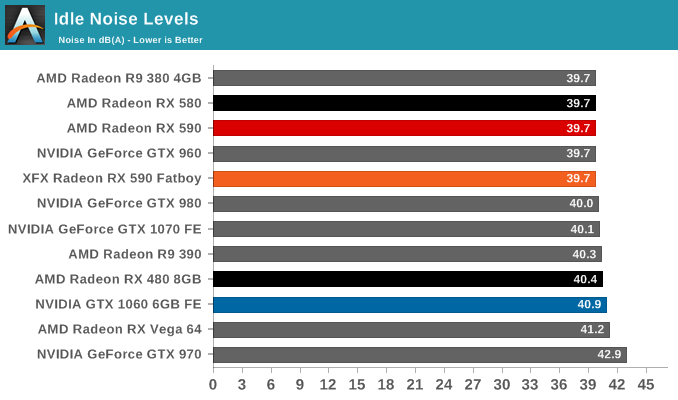
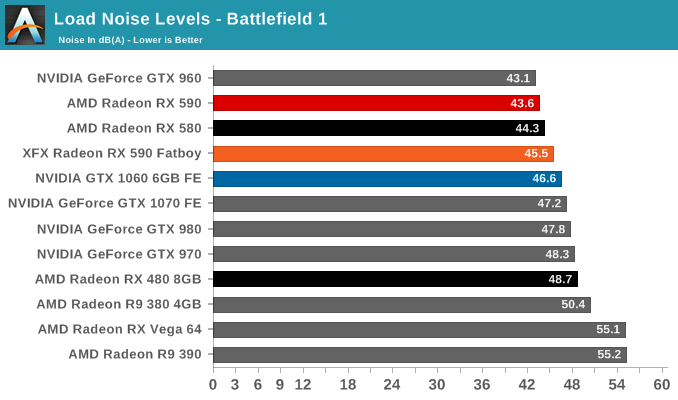
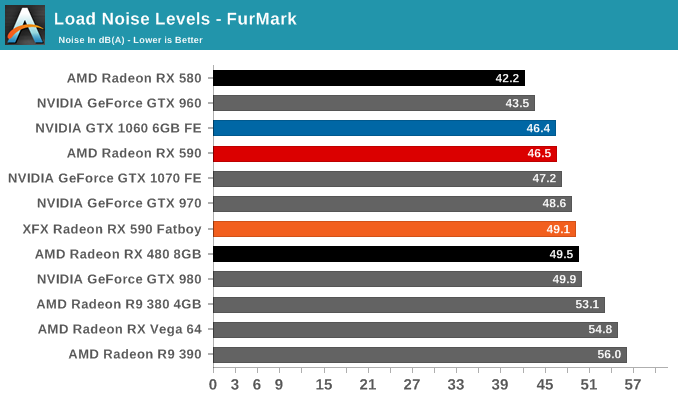
Additionally, a quick glance at RX 590 power consumption at -25% and -50% power limits show that like the RX Vega, RX 480, and RX 580, Polaris 30 is well past the optimal point on the voltage curve with the clocks at hand.










136 Comments
View All Comments
Opencg - Thursday, November 15, 2018 - link
Its just a gap filler. It will help them make money from people wanting to get good performance at that price but... we're still waiting for the serious contenders. Vega refresh will be a little more toward the high end but... navi is where amd could potentially shift the market. RTX means you pay more for less performance outside rtx games. Navi is the opposite you pay less and get more. We need navi to function well and I believe amd can do it.neblogai - Thursday, November 15, 2018 - link
Is is not a gap filler. It is only there, because overproduction of P20 needs to be sold out first. Naturally- P30 should be a replacement of P20, at same price, with minimal investment by MAD or partners.eva02langley - Thursday, November 15, 2018 - link
Polaris is selling well, Vega, not so much beside mining. In Canada, the price are still having a huge price tag because the supply is just so low.Allan_Hundeboll - Thursday, November 15, 2018 - link
I am surprised a boost frequency increase of 15% nets 12% overall performance. Maybe Polaris isn't as starved for memory bandwidth, as people seem to think. Or AMD made other improvements besides the increased frequency...?mapesdhs - Thursday, November 15, 2018 - link
Frequency increases rarely produce linear performance gains, not when there are so many other aspects of a system that impact what's happening (main CPU, API, game engine, etc.)Allan_Hundeboll - Thursday, November 15, 2018 - link
Yes that is why I'm surprised 15% increase on the core frequency -without any increase of the Vram frequency, would result in 12% overall performance increase. Especially considering the "original Polaris" rx480 was configured with 1266Mhz core boost frequency and 2000Mhz Vram.If AMD figured 1266/2000MHz was near the sweet spot balance between core/mem speed then 1545/2000 would be severly starved for memory bandwidth.
So I'm wondering if 2000MHz memory speed was kind of wasted on the rx480? Or did AMD tighten the Vram timings on this new 590? Or maybe the near linear increase in performance is due to the higher tdp allowing the rx590 to sustain the boost clock while the 480 would throttle to base core frequency of 1120MHz?
SlowSpyder - Thursday, November 15, 2018 - link
Where is 7nm Vega??mapesdhs - Thursday, November 15, 2018 - link
Never going to happen, because gamers won't buy it.https://www.youtube.com/watch?v=guK2XoFbPFw
https://www.youtube.com/watch?v=USMlET3L7mA
Cyborg997 - Thursday, November 15, 2018 - link
Summer 2019 or late 2019. Definitely soon rtx fighter.schujj07 - Thursday, November 15, 2018 - link
The most surprising thing to me is just how good RX480 is when you look at the benchmarks. When it launched it was as fast as the GTX970, now it is faster than then GTX980 just due to drivers and newer games being able to use its resources better.